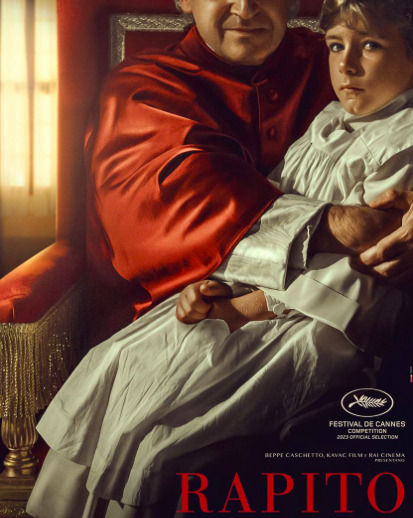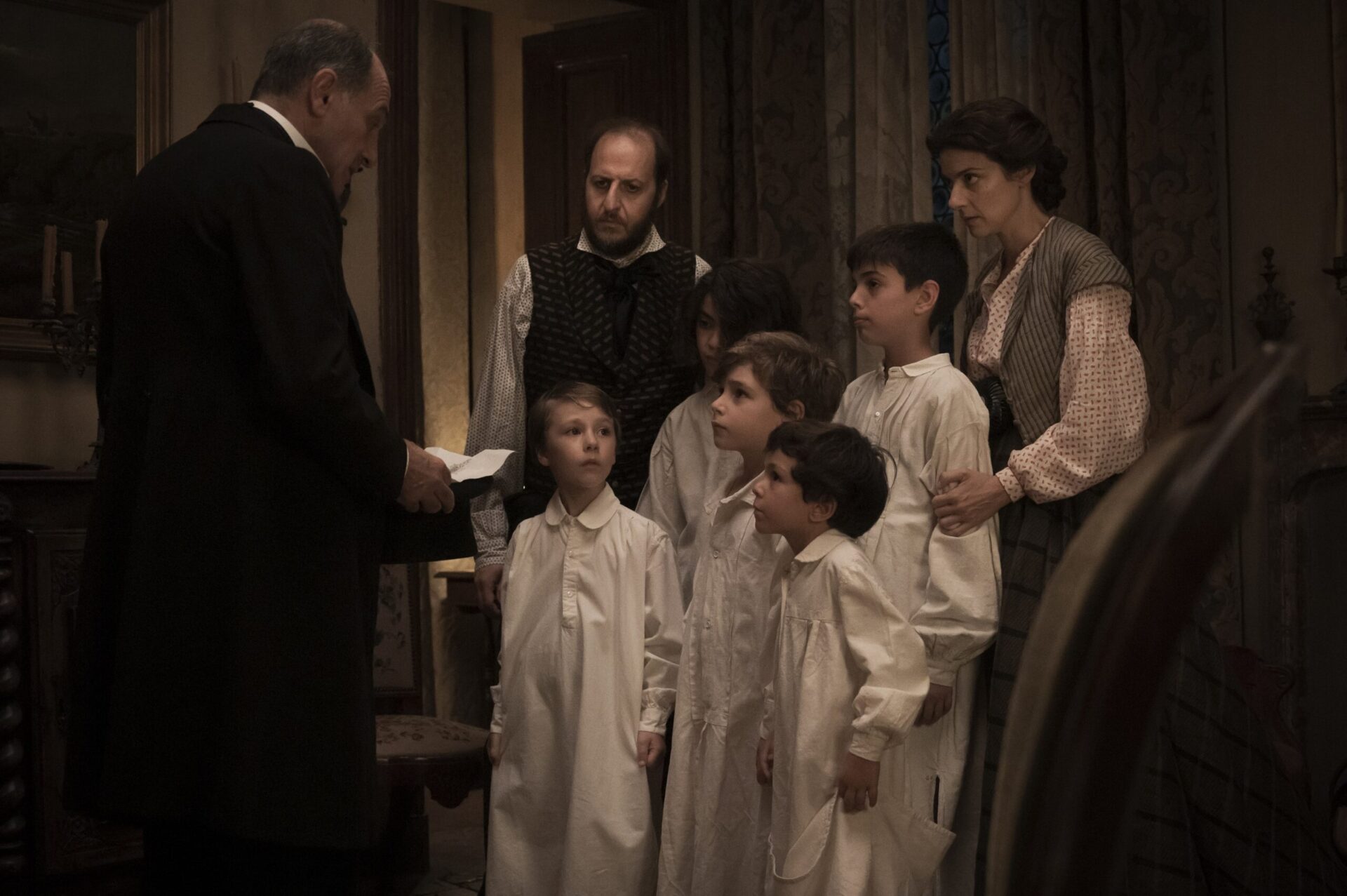
Marco Bellocchio, the secular director from Piacenza, has often explored the consequences of religious imposition — never being sententious yet remaining truthful to his laical perspective. In his 2002 film, My Mother’s Smile (L’ora di religione), he touched upon the sensitive issue of being baptised in treason. In that case it occurred to the son of the atheist protagonist and it characterised a small portion of the movie. But in his new film, presented at the 76th Cannes Film Festival, this act represents the beating heart of the motion picture.
Rapito (Kidnapped) is based on a true story that occurred during the Risorgimento, the time in history that lead the different states across the nation to unify into the Kingdom of Italy. Before the Italian army breached the Aurelian Walls near Porta Pia, in 1870, within the Papal States (that included today’s regions of Lazio, Emilia-Romagna, Marche and Umbria), the Pope had the role of sovereign of his realm. The so-called Pope King thus had the power over the lives of those who lived in the city of Bologna, which is where our story begins.
On the evening of June 23rd 1858, a seven year old Jewish boy, Edgardo (Enea Sala), was taken away from his father Salomone “Momolo” Mortara (Fausto Russo Alesi), his mother Marianna Padovani (Barbara Ronchi) and his numerous siblings. He was seized by the Papal gendarmes under the order of Cardinal Giacomo Antonelli (Filippo Timi), who was the Secretary of State of Pope Pius IX (Paolo Pierobon). The Cardinal had been informed, by the zealous Inquisitor of the Holy Office, Dominican Pier Gaetano Feletti (Fabrizio Gifuni), that the Israelite child had been baptised. Thus, Edgardo Mortara had to be raised as a Catholic. The christening had been carried out in secret by Anna Morisi, the non-Jewish peasant maid of the Mortara family, when Edgardo was six months old, in 1852, and was severely ill. The woman feared that if the baby died he would end up in limbo.
Only six years later, perhaps also for money, Anna confessed what she did. Her revelation triggered an inhumane provision that at the time was considered legitimate according to the strict rules of canon law. Transferred from his home in Bologna’s via Lame to the Casa dei Catecumeni in Rome, Edgardo was raised according to Christian precepts under the custody of Pope Pius IX, despite the protests of the Jewish and international community.

The forced conversion unleashed public opinion beyond the Italian borders: twenty articles appeared in the New York Times, Napoleon III expressed his opposition, as did the two Rothschild brothers. But this only strengthened the persistence of Pius IX who reigned over the Church from 1846 until 1878 and was the last Pope King who witnessed the crumbling of the Papal State. Through the years Edgardo met his parents a couple of times and when the Italian soldiers from the Bersaglieri regiments stormed through the walls of Rome, to put an end to the Pope’s reign, he was secretly transferred to Bressanone that at the time was part of Austria.
The striking trait about this real-life event is that Edgardo Mortara as an adult (Leonardo Maltese) fully embraced Catholicism. He abhorred the Capture of Rome that marked the final defeat of the Papal States.
Edgardo never returned to Judaism again and became a priest. He chose the name of Don Pio Mortara, as an homage to Pius IX whom he considered his adoptive father (one would argue his choice was an effect of Stockholm Syndrome). At 89 years old he passed away in the Abbey of Bouhay in Liège, two days before the arrival of the Nazis, who probably would have killed him since their extermination wasn’t based on religious faith but on genetics and he was of Jewish descent.
Rapito is loosely based on Daniele Scalise’s book Il caso Mortara. La vera storia del bambino ebreo rapito dal Papa (The Mortara case. The true story of the Jewish child kidnapped by the Pope), as well as the publication of American historian David Kertzer Prigioniero del Papa Re (Prisoner of the Pope King).
The adaption of Edgardo Mortara’s story for the screen caught the interest of both Julian Schnabel and Steven Spielberg. The latter did not go through with the project because he couldn’t find the child-actor fit for the role of Edgardo. But the American filmmaker had even asked his screenwriter Tony Kushner to contact Mortara’s descendant: Elèna. Her paternal grandmother was Edgardo’s sister, Ernesta, who at the age of twelve witnessed the kidnapping of her little brother. Elèna took great dedication to divulge her great-uncle’s story, by publishing the book Writing for Justice in the United States, after learning with astonishment the news of the beatification of Pius IX. After seeing Bellocchio’s film she said: “It was very emotional to relive this story through the power of cinema. Bellocchio managed to enter the folds of the soul of the family and grasp the violence of what happened. The film focuses on the essence of an important moment in history, the Risorgimento, and the struggles for emancipation, not only of the Jews but of all the oppressed minorities in the mid-nineteenth century. I hope it can touch the public and enter the conscience of this country.
”
Kidnapped is a truly efficacious historiographic work penned by Marco Bellocchio with Susanna Nicchiarelli, who were helped by Alberto Melloni, the historian of Christianity who also consulted for Paolo Sorrentino’s series The Young Pope. Nineteenth-century Italy is recreated with finesse and brilliantly brought to life by the talented cast. The setting is further enhanced by the elegant pictorial cinematography of Francesco Di Giacomo and the enthralling music score by Fabio Massimo Capogrosso. The accurate minimalist realism of the scenery and costumes did not prevent Bellocchio to include a dreamlike dimension, with a stupendous scene where little Edgardo frees the crucified Christ. His act of childhood innocence shows how every dogma holds the mind hostage as it struggles for liberation.

The Italian filmmaker explained that his film had no political intent and was shown to both Catholic priests and members of the Jewish community, who were equally moved by it. He even wrote to Pope Francis to show him Rapito and is waiting to hear back from him. Once again, Marco Bellocchio’s cinema has the quality of being current, no matter what epoch he represents on the silver screen, because he leaves his spectators the utter freedom to ponder upon the topics he explores.
The theme of kidnapping seems to be recurring in Bellocchio’s filmography, since he described the abduction of the leader of the Christian Democrats Aldo Moro, in both Good Morning, Night and Exterior Night. Just like in those works, Kidnapped shows to what extent ideological fanaticism can lead to. In the case of Edgardo Mortara it is epitomised by the Latin, religious phrase that was initially the potential title of the film: ‘Non possumus’, meaning ‘We cannot’, i.e. the absolute moral determination to obey the Catholic Faith. You cannot question it. In fact, when Pius IX asks the Jewish children converted by force to define a dogma the only one capable of answering is Edgardo, who says: “It is a truth of faith that cannot be discussed.” He seems to follow the advice of his friend who, torn from the Ghetto, told him “to be smart” and let their teachers believe they accepted the conversion. At that stage young Edgardo is unable to foresee the long-term consequences of brainwashing. His story demonstrates how deeply anti-Judaism dug into his soul, to the point of transforming him into an agent of conversion, since he tried (and failed) to bestow the endured proselytism to his mother on her deathbed.
The meticulous historical reconstruction brings to light the anti-Jewish hostility that distinguished the Papal States. We observe how little Mortara was only one of a multitude of Jewish children who were taken away from their families to be converted. This was a practice that had begun during the 15th century with the Spanish Inquisition, that in Italy led to the erection of Rome’s ghetto at the request of Pope Paul IV in 1555. After the Edgardo Mortara case, it took many years before the Church, through John Paul II, condemned anti-Semitism as a sin. He was the first Pontiff to visit a synagogue in 1986 and establish diplomatic relations between the Holy See and Israel, declaring that Jews were Catholics’ “older brothers in faith.”
The lengthy list of people who converted through the centuries from Judaism to Catholicism — that some sources estimate may arrive up to 250,000 — were extorted, therefore they cannot be considered as valid. Hence, the forced adoption of religious theories “to find salvation” are still vividly perceived as a violation of human rights.
The Italian filmmaker does not point the finger against Catholicism alone, religion in general is placed under scrutiny. Edgardo embraced the Holy See’s axiom as an act of survival, as much as he blindly accepted until the age of six the mitzvahs of his family by reciting the Shema Yisrael every night. Rapito reflects upon the violence of power, as it questions religious fundamentalism, ranging between superstition, blind faith and the search for justice.
Bellocchio’s film reinforces the idea of how beliefs should not be formed on the basis of authority. The way a malleable mind was obnubilated by the doctrines that were forced upon it, underlines how unsecularised worldviews may cause irreparable damage. Rapito thusly becomes an ode to free-thought.
Final Grade: A

